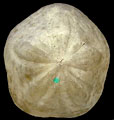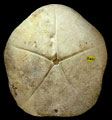The Echinoid Directory
Contributed by Jenna Sullivan, April 2007
Clypeaster reidii Wright, 1855, p. 54
| Diagnostic Features | Test large, broadly pentagonal, and much elevated; border abrupt, margin thin and undulated, rising with steep sides, and with a very little curve towards the vertex, which is nearly central; petaloid portions of the ambulacral areas large, nearly equal in width, and extending over nearly three-fourths of the sides; base quite flat; mouth small, pentagonal, nearly central; basal ambulacral sulci proceeding from the angles of the mouth, narrow, and sharply defined; anus round, near the posterior margin; tubercles on the upper surface small and closely set together, those on the base a little larger; apical disc nearly central and prominent, with an outer circle of genital holes, and an inner circle of eye-holes having the madreporiform tubercle in the centre. [Wright, 1855] |
|---|---|
| Distribution | Miocene of Malta. |
| Type | Holotype: Natural History Museum E1620 |
| Classification and/or Status | Species of Clypeaster |
| Remarks | Differs from C. umbrella in that C. reidii is more elongated, the petaloid ambulacra are longer and narrower, the interambulacra are flattened and slightly curved, the base is quite flat, and the oral lobes are curved acutely inwards. Differs from C. altus in that C. reidii is broader in proportion to its length, the petaloid ambulacra are narrower, the poriferous zones are not so open at the base, the mouth is smaller, the oral lobes curve acutely inwards, the border is thin and sharp, and the base is flat. [from Wright, 1855]. Wright, T. 1855. On Fossil Echinoderms from the Island of Malta; with Notes on the Stratigraphical Distribution of the Fossil Organisms in the Maltese Beds. Annals and Magazine of Natural History 15, 54. |



